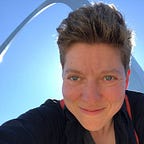The value in the gray area.
Our director is working on bringing innovation into the heart of every area of our organization. You can see this in his curatorial and education hires, you’ll find it in the restructure my position is part of, and you’ll see it as we start to roll out new public programming. The interesting thing is, more often than not, cultural organizations tend to be inward facing, so no matter how innovative they seek to become there’s a point where outsiders can be equally valuable in the equation; figuring out how to include them becomes as vital as the hiring and programmatic shifts within.
Those working on digital are often thought of as the innovators, but as I started thinking about innovation in my own area, I started to wonder about what role outsiders could play. A technologist would most typically come up with a hackathon, but those events have never worked very well because they sit too far outside the normal workings of the institution. You may host one, but the reality is it likely won’t change how people think outside of the technologists on staff. As an example, I had an excellent experience recently working with Cornell Tech, but the work produced was limited to those on our team.
I started to wonder — how can you create a forum that helps answer questions that the entire staff is working on?
2x4: an innovation forum at the Barnes Foundation is our answer to this; an annual event that seeks to bring external parties together around a big picture question facing the Barnes. The event pairs 2 thought leaders in Philadelphia with 4 students from Drexel’s ExCITe Center to work on something that’s a core part of what we are doing. Think of this project as a venn diagram — the event values the gray area that’s created when you bring together two disparate sets of outsiders with a key Barnes challenge.
In this year’s forum, we are going to focus on audience transformation because audience development is one of the most critical things that all staff at the Barnes have been working on. The majority of our audiences today reflect the suburbs from which we came and that makeup is predominantly older, white, highly educated, and wealthy. While it’s important to maintain our relationship with our current audience, it’s critical that we begin to foster an audience that is more reflective of the city of Philadelphia where we see considerably more variance. Our five-year strategic plan includes this as a major goal.
For 2x4, we’ve been lucky enough to engage two leaders in Philadelphia who work with diversity and inclusion every day — Maria G. Arias, Vice President of Diversity and Inclusion for Comcast Corporation, and Siobhan Reardon, the President and Director of the Free Library of Philadelphia. We’ve also been working with Youngmoo Kim and Kara Lindstrom over at Drexel’s Expressive & Creative Interaction Technologies Center to find four students who represent a variety of focus areas, grade level, and technical backgrounds.
2x4 seeks to put these folks together with an issue relevant to all of us and see what happens. Unlike a hackthon, there’s no deliverable, no contest, and no overnight working sessions. There are discussions — public and private — and there are working days that will end up in student responses of some kind, but 2x4 is a process. There’s a great deal of value being put on the process rather than a deliverable at the end of it.
There’s one other key voice in this program and that’s data. In order to grow new audiences, you need to know more about those who visit the Barnes, but also those who don’t. To this end, we’ve commissioned a survey from BeHeardPhilly at Temple University’s Institute for Survey Research and our goal in investing in this data gathering was to understand how knowledge about and perceptions of the Barnes vary throughout Philadelphia by zip code. As part of 2x4, we are releasing this data set and we hope that it becomes the center of this program. As it stands, this data is becoming part of our every day — informing our marketing, public programs, community engagement, website, and digital engagement planning.
I’d be remiss if I didn’t mention that 2x4 takes its inspiration from the Rhizome Seven on Seven Conference. This event creates its own gray area by pairing seven leading artists with seven influential technologists in teams of two, and challenges them to develop something new — be it an application, social media, artwork, product, or whatever they imagine — over the course of a single day. I’ve long been a fan of this program and, in tweaking this model, think it presents us with a great opportunity to involve disparate others in the inner workings of our institution.
If you are in Philadelphia or nearby, we hope you can join us for this program and watch the process unfold as we do. RSVP
2x4: an innovation forum at the Barnes Foundation is sponsored by Drexel University’s LeBow College of Business
